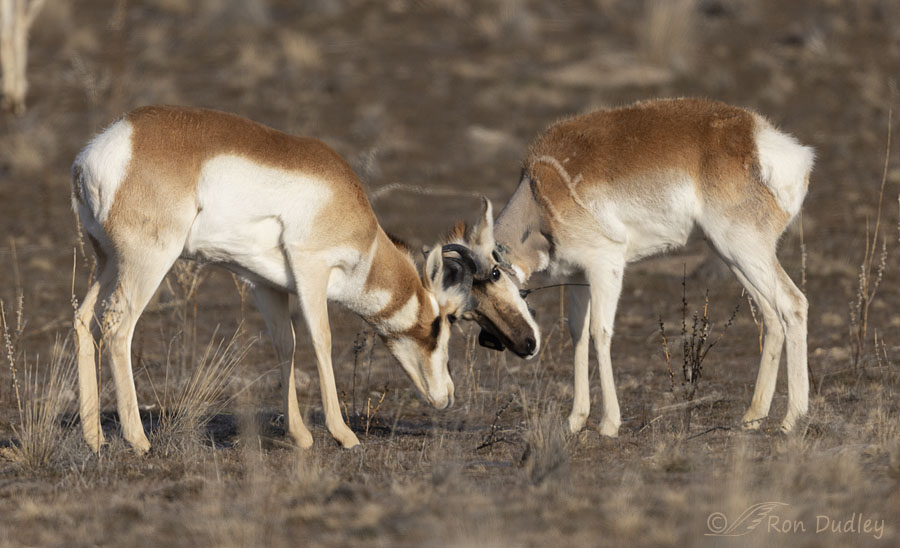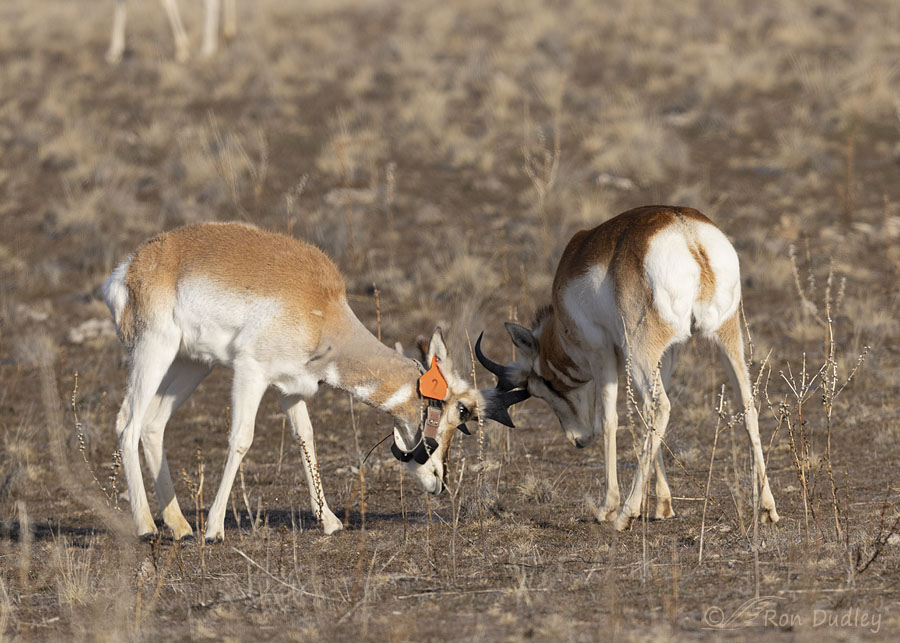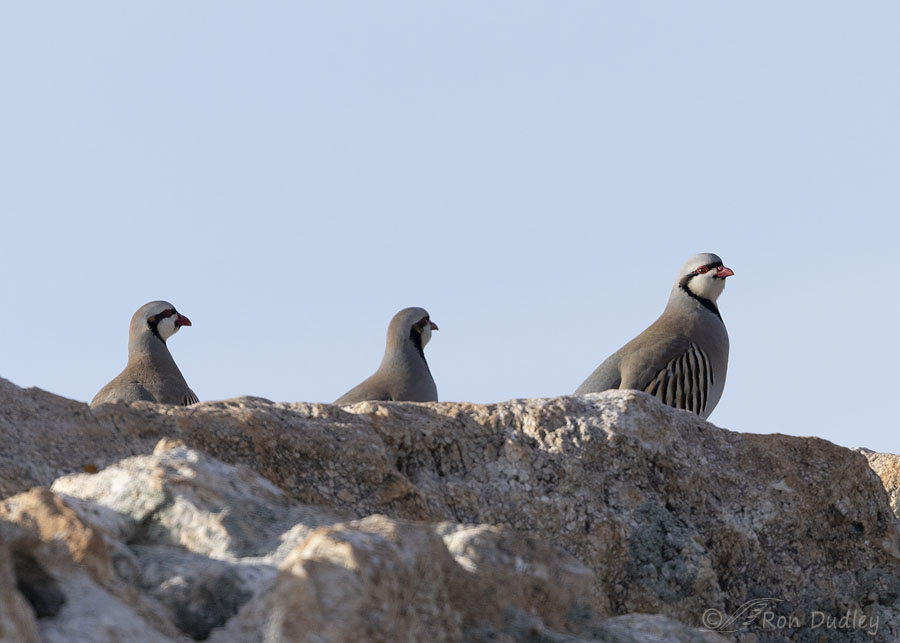A radio collar on a pronghorn buck that might be too loose?
It’s been a long time since I’ve seen any pronghorn on Antelope Island but three days ago I spent some quality time up close with a herd of 22 of them.

These two bucks spent almost three minutes jousting with each other. I got hundreds of photos of them sparring but as I mentioned in a recent post, I was having troubles with soft shots that morning (related to atmospherics I hope, instead of problems with my photo gear) so most of my pronghorn photos were soft. These two are some of the sharpest I got.
I don’t think it was a serious fight. To me it seemed more like play-fighting.
Yes, the buck on the right is wearing a radio collar and an orange ear tag. In this shot about all we can see clearly is the antenna of the radio collar sticking out sideways beneath his neck.

They were circling each other as they tussled so the buck with the jewelry is now on our left.
Initially I had some concerns about that radio collar. I know absolutely nothing about radio-collared pronghorn, but to me that collar seems far too loose and in some of my (soft) shots the actual collar looks like it could possibly be damaged. I have concerns that it would be easy for that loose collar to become entangled with something else in a variety of ways. Some possibilities – the buck could easily get one of his front legs stuck in the collar, or the horns of another buck could get caught in it while they’re fighting. Lots of unfortunate possibilities come to mind.
However, when I did a Google image search on “pronghorn with radio collar” it appears that at least some collars on pronghorn are almost this loose. Maybe they’re loose by design, so the collar can fit over the thicker lower part of their neck when their head is raised. I just don’t know.
So I’m throwing this out there in case someone sees this who’s more knowledgeable about radio collars on pronghorn than I am. Once again, my curiosity itch is begging to be scratched.
Ron
PS – On that same morning I saw something else that I hadn’t seen on the island in a very long time.

Chukars.
I can’t remember the last time I saw chukars on the island but it’s been far too long. These three were strongly side lit and they were quite wary of me but I was still delighted to see them and hear the one on the right calling. It gives me hope of getting better Chukar photos in the near future. And hopes that Chukars on the island are on the rebound.


Ohhh, Chuckars and Longhorns! I’ve got to get out to the island again.
Deedee, the downside is that the magpies seem to have disappeared from the island. All of them. I haven’t seen a single magpie on my last 4 trips to the island and I look hard for them. Both the park manager and the park naturalist told me they haven’t seen any for a while either.
It might be the same animal with a collar that I reported a few years back to the island management, I also sent an email along with photos of the poor animals neck. I will look back on my photos. I could actually see scabs and sores/wounds from the collar rubbing up and down the back of the neck. All the animals fur was gone as in your photo. I was told in an email response that biologist shave their necks for blood work by whoever it was responded to my email. I had a hard time believing what I was told. When I questioned the reply with another email I was told they would pass it on. End of correspondence.
April, you’re right to be skeptical about what they said about shaving its neck. For blood work they’d only shave a very small area, if they shaved any at all. Sounds like there was some CYA going on there.
Great capture, Ron! 🙂 “Something” is sure taking care of the hair on it’s neck… 🙁 Collar is WAY too loose IMO just asking to get hung up somewhere on something. Wonder if it was pretty young when collared and they were planning on growth? Bad news at any rate. We have a heard of about 50 between here and town hanging out near the road – always makes me nervious as I never know what they are going to do “en mass”.
Chukars are ALWAYS a wellcome site…. 🙂
Thanks, Judy. In the last several years I’ve heard faraway Chukars calling on the island a time or two but it had been a very long time since I’d seen any.
Michael’s got a good eye–I missed that. Also, it looked to me as if that pronghorn had a heck of a scar on his left shoulder ? And
beautiful chukars– you had a really productive morning ! That
very loose collar scares me, too…….
Kris, I wondered about that scar too Kris, if that’s what it is. Can’t imagine what else it could be.
I wonder if he got hung up in a fence with that loose collar. Antelope never evolve jumping up and over objects like mule deer. They will go underneath the fence or between the wires it’s a three or four strand barb wire fence. A woven fence three or four foot tall is a formidable barrier
Interesting post. We have pronghorns here and I have taken many photos of them – most at a distance, but I have never seen one with a radio collar and have no knowledge about them.
Thanks, Everett. I believe two of the 22 pronghorn in this herd had collars but I can’t be sure about the second one.
Chukars just naturally bring on smiles!
And that radio collar looks very scary – I’ve seen cats/dogs with feet stuck in a loose collar, and these pronghorns have such delicate looking legs! Do you think this is a resident herd that is being tracked, or one that is migrating? You sure have seen a lot of bling on your recent subjects – leg bands on the Kestrel, radio collar on the pronghorn…
Carolyn, the only kind of migration that pronghorn on the island can do is vertical (gaining elevation by going up and down the mountains). They’re residents on the island.
Gotta wonder about that collar. Comparing the two, it appears that the collar is wearing on the neck fur.
A quick internet search indicates that the Utah Division Wildlife is the one doing the collaring. Other photos I found show the collars fitting much more snugly.
Like the photo of the Chukars. Handsome birds. Have only seen them once out in the Mojave desert.
Hope your photos are a good sign that both populations are doing well.
“it appears that the collar is wearing on the neck fur”
Good eye, Michael. I think you’re right.